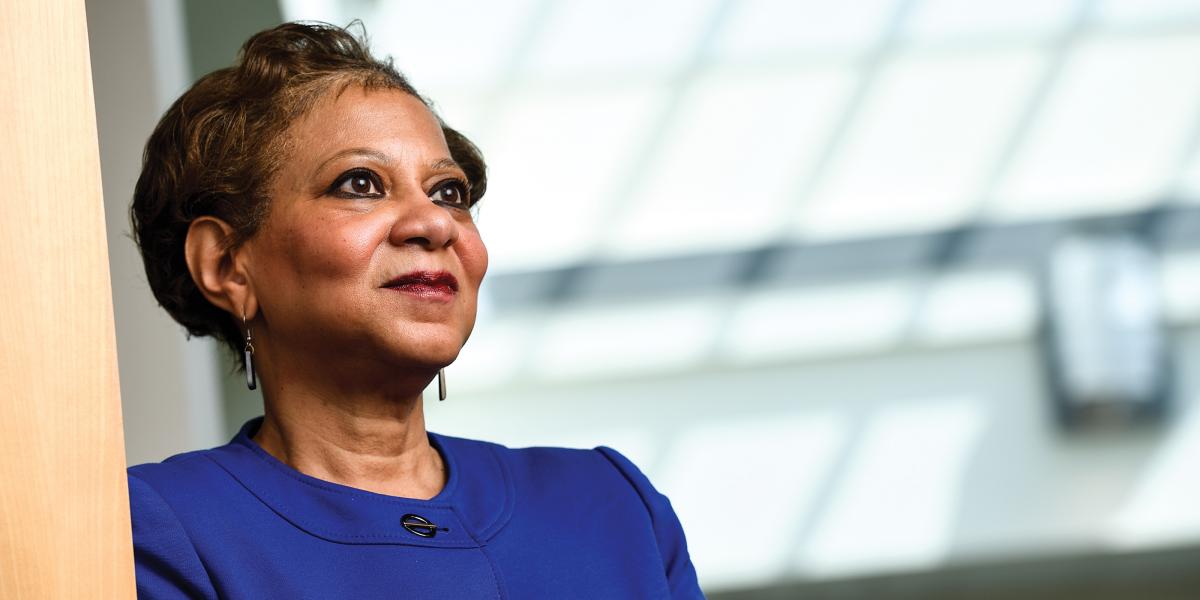Racism and COVID-19
Lisa Cooper explains why the pandemic hit African American communities especially hard.
There’s a saying that when America catches a cold, African Americans catch pneumonia. The axiom proved tragically true as COVID-19 cases began surging in the U.S. this spring. Nationally, African American deaths are nearly two times greater than would be expected based on their share of the population, according to The COVID Racial Data Tracker.
The heightened risk for communities of color was the first concern for Lisa A. Cooper, MD, MPH ’93, Bloomberg Distinguished Professor and director of the Johns Hopkins Urban Health Institute and the Johns Hopkins Center for Health Equity.
In this Q&A, Cooper, a practicing physician and epidemiologist, discusses racism’s role in COVID-19 cases in African American communities and solutions for the inequities.
Why are more African Americans dying of COVID-19 and suffering more from the pandemic?
Before COVID-19, minority communities were already disproportionately impacted by health inequities. People in those communities already have higher rates of obesity, diabetes, heart disease, and lung disease, so these are the folks who were actually going to be at more risk of getting seriously ill with COVID-19. These health inequities result from the financial stresses of being poor and the social stresses of being from a marginalized group with a history of institutionalized, sanctioned mistreatment by law enforcement and other societal institutions.
There’s a confluence of all these different factors—not having access to food, not having access to good quality housing, being crowded in small houses where there are multiple generations and unable to engage in social distancing or stock up on groceries for several weeks at a time, having to use public transportation, to work in essential jobs, and having less access to health care. These are all manifestations of structural racism.
Are you concerned that higher-risk populations might be stigmatized?
Yes, there is always the concern that when we highlight that certain groups are disproportionately impacted by a condition known to be deadly and easily spread, those groups will experience stigma. This is even more concerning for people of color and poor persons because they are often the target of bias and negative stereotypes—interpersonal racism. To counteract these negative stereotypes, we must balance the narrative around health disparities that overemphasizes individual responsibility with an examination of our collective social responsibility. Do our laws and organizational practices provide everyone with the opportunities they need to be healthy? We should make the links between social conditions and health clearer.
The pandemic could bring a shift in thinking toward valuing all people regardless of background, economics, or what’s on the surface.
What can be done right now to reduce the toll of COVID-19 on Black and minority communities?
Keeping an eye on the data is an important priority: knowing who is impacted and where they’re impacted.
Communication is also really important—making sure that the public understands why we might be seeing these patterns, and that it’s more about our society and the way our resources and opportunities are allocated than it is about individual behaviors. We need to do what we can to better understand the challenges of those communities, engage with trusted leaders, listen with respect, and show empathy and concern. We need to recognize the remarkable contributions of African American communities and follow our words up with real actions that bring about positive change.
We also need to focus on frontline workers and low-wage workers, and understand their needs—providing protective equipment, safe spaces to work, paid sick leave, hazard pay, or health insurance and access to testing and care. And, we need to provide for people’s basic needs: stable housing, food security, and digital access to education and health care.
Why is leadership from within the community important for ensuring that the response reaches disadvantaged populations?
Community leadership is important across the board during a pandemic when cooperation among government and private sector groups is essential. We have seen communities where social distancing is not being practiced getting hit hardest. The results have been better where there is greater trust in leadership, and where leaders began earlier with fact-based, consistent messaging to the public but gave no false reassurances. This strategy is particularly important in ethnic minority communities where discrimination is common and people are predisposed to fear and distrust authority.
In disadvantaged communities, leaders are not necessarily people with titles or elected officials; they are the people who have served others in ways that enable them to deliver well-received messages.
Could this pandemic open the door to new solutions to reduce health disparities?
I think the COVID-19 pandemic has revealed how interconnected and vulnerable we all are, and how our well-being depends as much on what those around us do as our own steps. When others don’t have the opportunity to be healthy by engaging in social distancing, it puts all of us at risk.
The pandemic could bring a shift in thinking toward valuing all people regardless of background, economics, or what’s on the surface. We know now more than ever that every member of our society is important. It may force us to come up with new ways, including technology, to connect everyone with the things they need.
What makes you hopeful about the future?
I see people coming together in a way that they haven’t in a very long time. I see a lot of empathy and connections based on our shared vulnerability. I see leaders committing to make real changes.
This is also an opportunity to remember that our fates are intertwined. The pandemic has shown us that what happens to one of us affects all of us. If we want to be healthier and have more opportunities, it’s not enough to just worry about ourselves.
